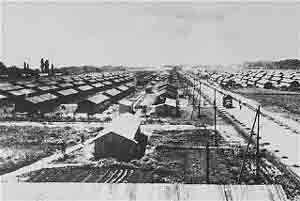Nazi Transit Camps: Gurs
The Gurs camp was one of the first and largest camps established in prewar France. It was located in the Basque region of southwestern France, just to the south of the village of Gurs. The camp, about 50 miles from the Spanish border, was situated in the foothills of the Pyrenees Mountains northwest of Oloron-Sainte-Marie.
 |
In early 1940, the French government also interned about 4,000 German Jewish refugees as “enemy aliens,” along with French leftist political leaders who opposed the war with Germany. After the French armistice with Germany in June 1940, Gurs fell under the authority of the new collaborationist French government, the Vichy regime.
In October 1940, German authorities deported about 7,500 Jews from southwestern Germany across the border into the unoccupied zone of France. Vichy officials then interned most of them in Gurs. Of this group, 1,710 were eventually released, 755 escaped, 1,940 were able to emigrate, and 2,820 men were conscripted into French labor battalions.
In 1941, there were 15,000 internees, including 7,200 Jews who had been deported from the Palatinate and Baden in western Germany, and about 3,000 Jewish refugees who had been arrested in Belgium on May 10, 1940, and had been sent first to the French concentration camp Saint-Cyprien on the Spanish border.
In the second half of July 1942, Theodor Dannecker, Adolf Eichmann's representative in France, inspected the Gurs camp. Subsequently, between August 6, 1942 and March 3, 1943, Vichy officials turned over 3,907 Jewish prisoners from Gurs to the Germans; the Germans sent the majority of them to the Drancy transit camp outside Paris in northern France. From Drancy, they were deported in six convoys to the extermination camps in occupied Poland, primarily Auschwitz.
BIBLIOGRAPHY:
Z. Szajkowski, Analytical Franco-Jewish Gazetteer (1966), 214–2; J. Weill, Contribution à l'histoire de camps d'internement dans l'Anti-France (1946). ADD. BIBLIOGRAPHY: M.R. Marrus and R.O. Paxton, Vichy France and the Jews (1981), 172–3, 306–7.
Sources: U.S. Holocaust Memorial Museum;
David Weinberg, “Gurs,” Encyclopaedia Judaica. © 2007 The Gale Group. All Rights Reserved.


